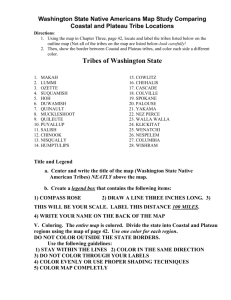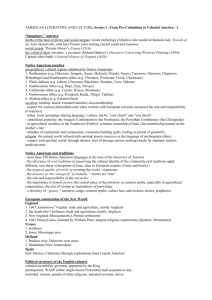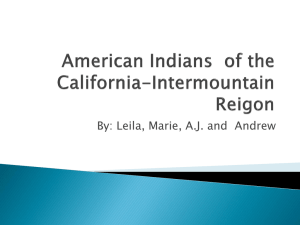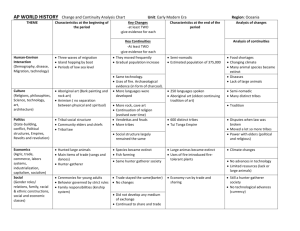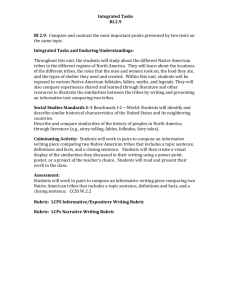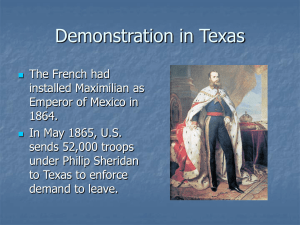Cheyenne Arapaho Tribes of Oklahoma v. United States
advertisement
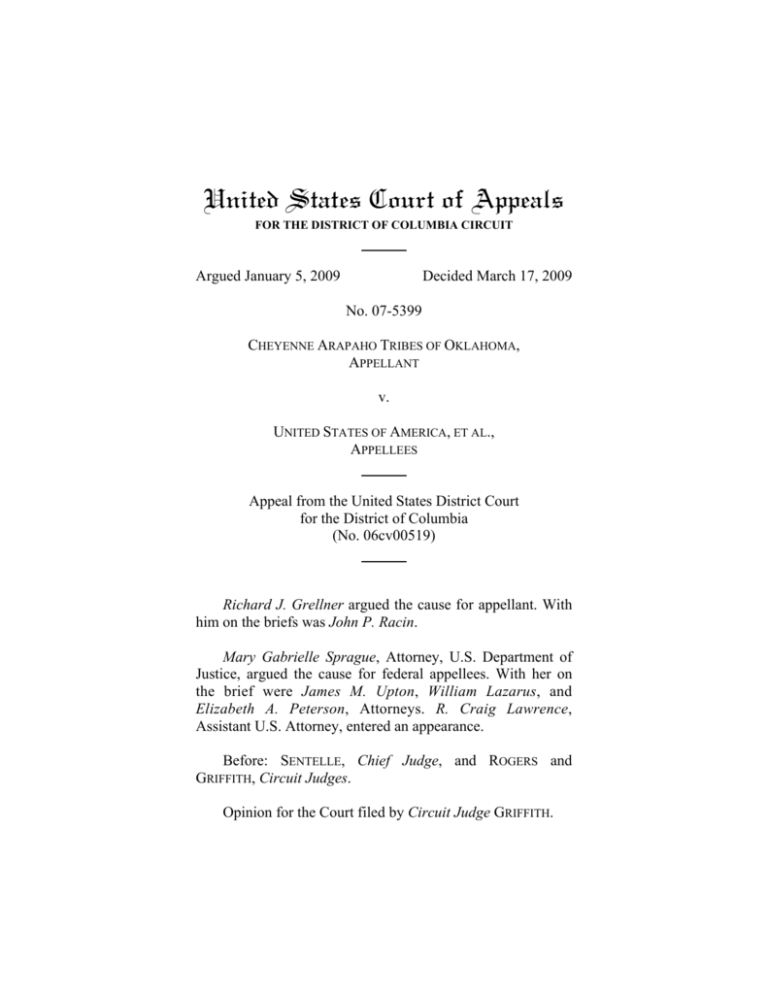
United States Court of Appeals FOR THE DISTRICT OF COLUMBIA CIRCUIT Argued January 5, 2009 Decided March 17, 2009 No. 07-5399 CHEYENNE ARAPAHO TRIBES OF OKLAHOMA, APPELLANT v. UNITED STATES OF AMERICA, ET AL., APPELLEES Appeal from the United States District Court for the District of Columbia (No. 06cv00519) Richard J. Grellner argued the cause for appellant. With him on the briefs was John P. Racin. Mary Gabrielle Sprague, Attorney, U.S. Department of Justice, argued the cause for federal appellees. With her on the brief were James M. Upton, William Lazarus, and Elizabeth A. Peterson, Attorneys. R. Craig Lawrence, Assistant U.S. Attorney, entered an appearance. Before: SENTELLE, Chief Judge, and ROGERS and GRIFFITH, Circuit Judges. Opinion for the Court filed by Circuit Judge GRIFFITH. 2 GRIFFITH, Circuit Judge: This appeal involves disputed rights to land originally designated as part of a reservation for the Cheyenne Arapaho Tribes of Oklahoma and later set apart by executive order as a U.S. military installation. The district court dismissed the Tribes’ action to quiet title to the land for lack of subject matter jurisdiction. The Tribes argue that the court erred in dismissing the case prematurely without allowing for jurisdictional discovery. Because the Tribes fail to specify what facts discovery could produce that would alter the jurisdictional analysis, we hold that the district court did not abuse its discretion in denying the Tribes’ discovery request. I. The train of events from which this appeal arises was set in motion nearly 140 years ago. In 1869, President Ulysses S. Grant designated more than five million acres in north-central Oklahoma as a reservation for the Cheyenne Arapaho Tribes of Oklahoma. Exec. Order (Aug. 10, 1869), reprinted in 1 INDIAN AFFAIRS: LAWS AND TREATIES 841 (Charles J. Kappler ed., 1904). In 1883, President Chester A. Arthur carved out 9493 acres from within the reservation “for the post of Fort Reno,” which was to be used “for military purposes exclusively.” Exec. Order (July 17, 1883), reprinted in 1 INDIAN AFFAIRS, supra, at 842–43. The Tribes claim this stipulation gave them a reversionary interest that would vest if the land was used for anything other than military purposes. See Appellant’s Br. at 2. After the cavalry abandoned Fort Reno in 1908, the Army used the post as a remount service depot, breeding and training horses and mules for military use. The Army’s use of Fort Reno waned in the 1930s as motor vehicles began to replace horses and mules as the predominant form of military 3 transportation. In 1937, Congress transferred 1000 acres of Fort Reno land to the Department of Justice for use by the Bureau of Prisons as a federal reformatory. Act of May 24, 1937, Pub. L. No. 75-103, 50 Stat. 200. In 1948, Congress transferred the remaining 8493 acres to the Department of Agriculture (USDA) for “livestock and agricultural” purposes, Act of Apr. 21, 1948, Pub. L. No. 80-494, 62 Stat. 197, and the following year USDA began a cooperative research program at Fort Reno studying the selective breeding of beef cattle and swine. Pursuant to an agreement with USDA, the Army continued to use approximately 600 acres at Fort Reno until 1954 to raise and train horses for the Turkish army. See J.A. at 55. The Tribes allege that the acreage transferred to USDA in 1948 was placed on military “standby status” as part of a classified agreement with the Army in 1954. Appellant’s Reply Br. at 5. The government disputes the confidential nature of this arrangement, noting that several newspaper articles from 1954 reported that the Army asked USDA to keep the buildings and pasture acreage previously used for the Turkish aid program ready for possible needs in connection with the “Indo China crisis.” See, e.g., Army Asks for Retention of Fort Reno by Government for Possible Military Need, EL RENO AM., May 20, 1954. In 1890, the Tribes entered a Cession Agreement, ratified by Congress the next year, in which they agreed to relinquish their interest in the reservation, subject to the allotment of 160-acre tracts to individual members of the Tribes. By the terms of the agreement, the Tribes agreed to “cede, convey, transfer, relinquish, and surrender forever and absolutely, without any reservation whatever, express or implied, all their claim, title and interest, of every kind and character, in and to” specified lands, as well as to “all other lands or tracts of 4 country in the Indian territory to which they have or may have set up or allege any right, title, interest or claim whatsoever.” Cession Agreement, art. II, 26 Stat. 989, 1022–23 (1891). The agreement made no mention of any reversionary interest the Tribes might have in the Fort Reno land. In 1958, the Tribes filed suit with the Indian Claims Commission (ICC),1 arguing they had received an unconscionably small consideration for the cession of reservation lands, asserting a claim to the reasonable value of the 9493 acres of Fort Reno, and seeking “reasonable and fair damages for the failure of the Secretary of the Interior to require the return of said lands to the use and benefit of [the Tribes].” J.A. at 264–65. The claims went to trial in 1965, but the Tribes settled for $15 million before the ICC could render a decision. See Cheyenne-Arapaho Tribes v. United States, 16 Ind. Cl. Comm. 162 (1965). The settlement agreement contained several finality clauses, including one that read: “Entry of final judgment in said amount shall finally dispose of all rights, claims or demands which the petitioner has asserted or could have asserted with respect to the subject matter of these claims.” Id. at 171–72 (quoting Stipulation for Entry of Final Judgment). In 2006, the Tribes brought suit in district court to quiet title to the Fort Reno land, claiming the property was outside the scope of the 1891 Cession Agreement and that they held a reversionary interest, which vested when the land ceased to be used exclusively for military purposes. The United States 1 Congress established the ICC in 1946 as a quasi-judicial body with authority to determine the merits of all Indian claims against the United States that accrued prior to its establishment. See Act of Aug. 13, 1946, Pub. L. No. 79-726, 60 Stat. 1049. The ICC had only a temporary mandate and was abolished in 1978. See Act of Oct. 8, 1976, Pub. L. No. 94-465, 90 Stat. 1990. 5 moved to dismiss for lack of subject matter jurisdiction on the ground that the Tribes’ claim was barred by the twelve-year statute of limitations in the Quiet Title Act, 28 U.S.C. § 2409a(g) (2000). The United States moved, in the alternative, for summary judgment on its affirmative defense that the 1965 settlement of the Tribes’ ICC suit precludes a later quiet title action. The Tribes subsequently filed a motion under Federal Rule of Civil Procedure 56(f), arguing that the district court should not decide the statute of limitations issue without first permitting discovery regarding the date on which military use of Fort Reno ended and the Tribes’ alleged claim to beneficial title accrued. The district court denied the Tribes’ Rule 56(f) motion, concluding that they failed to “show that additional discovery would be beneficial to . . . establishment of jurisdiction.” Cheyenne-Arapaho Tribes v. United States, 517 F. Supp. 2d 365, 374 (D.D.C. 2007) (quoting Med. Solutions, Inc. v. C Change Surgical LLC, 468 F. Supp. 2d 130, 135–36 (D.D.C. 2006)). The court granted the government’s motion to dismiss, identifying several points in time—each more than twelve years prior to the suit—at which the Tribes “should have been reasonably aware” that the United States had taken action adverse to their alleged reversionary interest in the Fort Reno land. Id. at 371. In a footnote the Court accepted the government’s alternative argument that the Tribes lost the right to assert their claim under the terms of the 1965 settlement of their ICC suit. Id. at 372 n.3.2 2 The Tribes moved to alter or amend this portion of the judgment pursuant to Federal Rule of Civil Procedure 59(e), arguing that the ICC lacked jurisdiction over their claims and that the record showed the land set aside for Fort Reno was not subject to the ICC settlement. The district court denied the motion. Cheyenne-Arapaho Tribes v. United States, No. 06-0519 (D.D.C. Nov. 8, 2007). 6 This appeal followed. The Tribes argue that the district court erred in denying their request for discovery to identify continuing military activity at Fort Reno and in concluding that the settlement of their ICC suit precludes the present quiet title action. We have jurisdiction under 28 U.S.C. § 1291 and review the district court’s denial of the Tribes’ discovery request for abuse of discretion. See FC Inv. Group LC v. IFX Markets, Ltd., 529 F.3d 1087, 1091 (D.C. Cir. 2008). Because we conclude that the district court did not abuse its discretion in denying jurisdictional discovery and that it properly dismissed the case for lack of subject matter jurisdiction, we need not consider the Tribes’ arguments about the ICC settlement agreement. II. A. The Quiet Title Act, 28 U.S.C. § 2409a, which waives the United States’ sovereign immunity for certain quiet title actions, is the “exclusive means by which adverse claimants [may] challenge the United States’ title to real property.” Warren v. United States, 234 F.3d 1331, 1335 (D.C. Cir. 2000) (alteration in original) (quoting Block v. North Dakota, 461 U.S. 273, 286 (1983)). Of dispositive relevance here, the Act provides that “[a]ny civil action under this section . . . shall be barred unless it is commenced within twelve years of the date upon which it accrued,” 28 U.S.C. § 2409a(g). An action accrues “on the date the plaintiff or his predecessor in interest knew or should have known of the claim of the United States.” Id. We apply a “test of reasonableness” to determine whether a plaintiff “knew or should have known” of a federal claim to real property. D.C. Transit Sys., Inc. v. United States, 717 F.2d 1438, 1441 (D.C. Cir. 1983). “Knowledge of the claim’s full contours is not 7 required. All that is necessary is a reasonable awareness that the Government claims some interest adverse to the plaintiff’s.” Warren, 234 F.3d at 1335 (quoting Knapp v. United States, 636 F.2d 279, 283 (10th Cir. 1980)). The Tribes contend that the Act’s statute of limitations begins to run only when their reversionary interest in the land is triggered, which, according to their theory of the case, occurs when the government ceases to use Fort Reno exclusively for military purposes. The Tribes do not challenge directly the district court’s finding that, on the record before it, they knew or should have known more than twelve years prior to their suit that the United States claimed the right to use Fort Reno land without limitation. Instead, the Tribes argue that the district court abused its discretion by refusing to allow jurisdictional discovery, which “could well show continuing military status in the lands of Fort Reno, such that the Tribes’ claimed reversionary interest may not yet have accrued.” Appellant’s Br. at 17. The Tribes requested a continuance to pursue discovery under Federal Rule of Civil Procedure 56(f), which provides that a district court may allow for discovery if a party opposing summary judgment “shows by affidavit that, for specified reasons, it cannot present facts essential to justify its opposition.”3 The Tribes’ supporting affidavit identifies recently declassified documents that suggest “the Army fully intended to make continued use of the lands for military purposes,” and asserts that further discovery could undermine “the Government’s argument the Tribe has long been on notice of all the facts relating to their claimed reversionary interest in Fort Reno.” J.A. at 356. 3 Although Rule 56(f) formally applies only in the context of a motion for summary judgment, its discovery standards are also appropriate for parties responding to a Rule 12(b)(1) motion to dismiss. See Gordon v. Nat’l Youth Work Alliance, 675 F.2d 356, 360 (D.C. Cir. 1982). 8 We hold that the district court did not abuse its discretion in denying jurisdictional discovery given the absence of any specific indication from the Tribes regarding “what facts additional discovery could produce that would affect [the court’s] jurisdictional analysis,” Mwani v. bin Laden, 417 F.3d 1, 17 (D.C. Cir. 2005) (quoting Goodman Holdings v. Rafidain Bank, 26 F.3d 1143, 1147 (D.C. Cir. 1994)). The Tribes failed to specify how the requested discovery would alter the court’s determination that the statute of limitations had long since run and extinguished their claim. See Byrd v. EPA, 174 F.3d 239, 248 n.8 (D.C. Cir. 1999) (noting that conclusory assertions about the potential value of discovery are insufficient unless supported by specific discoverable facts). The Tribes sought discovery to bring to light any “continuing military uses” on the Fort Reno land. J.A. at 357. But the Tribes “knew or should have known,” 28 U.S.C. § 2409a(g), that the United States had used the land for nonmilitary purposes from actions taken by Congress in 1937 and 1948 that transferred sections of Fort Reno from the Department of War to the Departments of Justice and Agriculture. These transfers put the Tribes on notice that the government continued to claim the land even though it was no longer being used for “military purposes exclusively,” in direct conflict with the Tribes’ alleged reversionary interest under the 1883 executive order. See Warren, 234 F.3d at 1336 (finding notice of the government’s claim to real property when the President issued a proclamation declaring an island reserved for certain uses inconsistent with private ownership).4 At either of those points in time, the Tribes 4 Moreover, the Tribes’ 1961 Severed Petition to the Indian Claims Commission, in which they asked the ICC to “set[] aside the jurisdiction of the Department of Agriculture conferred by the Act of April 21, 1948,” J.A. at 70, shows that the Tribes had actual knowledge of the 1948 transfer of Fort Reno land to USDA. 9 should have known of the government’s adverse claim, and the statute of limitations began to run. Any additional information or documentation regarding partial military uses, or suggestion that the land might be used for future military purposes, would not change the court’s jurisdictional analysis. The Tribes seek to avoid the force of the Quiet Title Act’s statute of limitations on the slender reed that their alleged reversionary interest in the land accrues only when Fort Reno is used for something other than military purposes. Putting aside any doubts about whether they in fact possess such a reversionary interest, even by its own terms the Tribes’ statute of limitations argument fails because the United States long ago abandoned exclusive military use of the land. The statute of limitation for the Tribes’ claims, if they had any, began to run as soon as the government used Fort Reno for something other than a military purpose. More than twelve years have since elapsed and the Tribes’ quiet title action is therefore time-barred. B. The Tribes also suggest, albeit in a footnote, that even if their original quiet title action accrued no later than when Congress transferred jurisdiction over Fort Reno to the Departments of Justice and Agriculture, discovery might show that the United States later abandoned its adverse claim by once again devoting Fort Reno to military uses. See Appellant’s Br. at 17 n.7. In such circumstances, according to the Tribes, a new limitations period would begin to run if and when the government subsequently reasserted a claim adverse to the Tribes’ reversionary interest. In support of this theory, the Tribes cite Shultz v. Department of Army, 886 F.2d 1157 (9th Cir. 1989), in which the Ninth Circuit held that “[i]f the government has apparently abandoned any claim it once 10 asserted, and then it reasserts a claim, the later assertion is a new claim and the statute of limitations for an action based on that claim accrues when it is asserted,” id. at 1161. The Shultz court suggested that if, after physically restricting access to a roadway running through part of a military installation, the Army thereafter failed for several years to restrict access, members of the public who used the road during that time might reasonably “believe that the government did not continue to claim an interest in the roadway.” Id. Subsequent efforts to restrict access would constitute a new claim for which a fresh statute of limitations period would only then begin to run. Id. The Tribes fail to mention that the Ninth Circuit later limited its abandonment-and-new-claim holding to “claim[s] of an easement,” concluding that “a reasonable plaintiff could not believe that the United States had abandoned its claim of a possessory interest in public lands merely because it failed to enforce restrictions upon public access,” Kingman Reef Atoll Invs., LLC v. United States, 541 F.3d 1189, 1199 (9th Cir. 2008) (“It is well established that the United States does not abandon its claims to property by inaction.”). The Eighth Circuit has likewise concluded that the United States does not abandon a claim to property for purposes of § 2409a(g) unless it “clearly and unequivocally abandons its interest” through some official action. Spirit Lake Tribe v. North Dakota, 262 F.3d 732, 739 (8th Cir. 2001). This standard is supported by the Quiet Title Act itself, which established a method for the United States to disclaim its interest in real property by filing a formal disclaimer with the court. See 28 U.S.C. § 2409a(e). The Tribes’ assertion that further discovery might show express abandonment of the government’s claims to Fort Reno is unavailing because the materials the Tribes seek would not demonstrate abandonment of the United States’ 11 interest in the land. The only document to which the Tribes’ discovery affidavit specifically refers is a transcript of 1954 hearings conducted by two congressmen in El Reno, Oklahoma. The Tribes suggest the transcript might show that the congressmen either made representations contrary to the United States’ continuing adverse interest in the property or “obscured the actual nature and status of the Fort Reno lands.” J.A. at 357. But nothing said by government representatives during such hearings, which were open to tribal members and the subject of several newspaper reports, could undermine the official actions taken by Congress in 1937 and 1948 demonstrating the United States’ property interest in Fort Reno. See Kingman Reef, 541 F.3d at 1200 (holding that one may not reasonably decide whether the United States has abandoned a claim to property on the basis of informal remarks of government officials); cf. Warren, 234 F.3d at 1338 (noting that in many circumstances “the Government cannot abandon property without congressional authorization”).5 The United States asserted claims to Fort Reno that were adverse to the Tribes’ alleged reversionary interest in the land by acts of Congress transferring parts of the property to 5 Similarly, the type of internal agency documents upon which the Tribes rely, see, e.g., Appellant’s Reply Br. at 4–6, are insufficient to indicate abandonment of government claims of interest in property. See Kingman Reef, 541 F.3d at 1200 (“[W]here the United States’s claim of interest in property stems from formal actions of the legislative or executive branch, a person could not reasonably conclude that . . . internal agency memoranda could eliminate the cloud upon the property’s title.”); Spirit Lake Tribe, 262 F.3d at 740–42 (holding that an internal memorandum authored by an Associate Solicitor in the Department of Interior could not establish abandonment of property because “intra-office memoranda do not bind the government”). 12 nonmilitary entities and uses. The Tribes fail to show that jurisdictional discovery would (or could) uncover specific evidence of official abandonment unavailable through other means. The district court thus was well within its discretion to deny the Tribes’ discovery request. III. We affirm the district court’s denial of the Tribes’ motion for a continuance to permit discovery. Because the district court correctly determined that it lacked subject matter jurisdiction over the Tribes’ claims, we do not reach the court’s alternative conclusion that the 1965 settlement of the Tribes’ ICC suit also bars their present action. So ordered.

